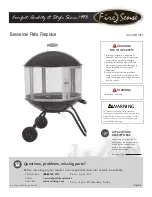
3
The Promax XL heat exchanger systems are rated at “Nominal”
conditions. Their actual performance may vary significantly
based on application. System design should be undertaken only
by technically qualified individuals with an understanding
of pumps, recirculating water piping and heating applications.
These instructions do not cover load sizing or hydronic
heating requirements, but rather provide a means for selecting
the correct side loop water heater and heat exchanger to provide
a specific target heat output.
The RXLD Series is of vented double-wall construction for those
applications where design or local codes require double isolation
between fluid streams. Where applications may have a freeze
potential on the secondary side piping, propylene glycol may
be used to provide freeze protection.
NOTE: Ethylene glycol should not be used
.
When selecting equipment for XL applications first compare the
target heating capacity to the listed output for the water heaters.
Prior to purchasing the water heater be sure to confirm water
heater specifications with current literature for the chosen product
SELECTING EQUIPMENT
FIGURE 2
PROMAX
XL
SL
MODELS
OUTPUT
APPLICATIONS
GCVH-40L
29,600
ALL XL MODELS
GCVT-40L
35,500
ALL XL MODELS
STANDARD
GCVT-50L
38,000
ALL XL MODELS
VENT
GCVX-50L
50,050
ALL XL MODELS
GCG-65L*
49,400
ALL XL MODELS
FCG-75L*
57,000
ALL XL MODELS
XGV-40L
30,400
ALL XL MODELS
XGV-50L
32,400
ALL XL MODELS
GCVH-40Q
29,600
ALL XL MODELS
DYNA-
GCVT-40Q
35,500
ALL XL MODELS
CLEAN II
GCVT-50Q
38,000
ALL XL MODELS
GCVX-50Q
50,100
ALL XL MODELS
GCG-65Q*
49,400
ALL XL MODELS
FCG-75Q*
60,100
ALL XL MODELS
GDVH-40L
30,000
RXLS 28 & 52 ONLY
GDVH-50L
36,000
ALL XL MODELS
GDVH-75L*
41,800
ALL XL MODELS
GPST-40L
38,000
ALL XL MODELS
POWER
GPST-50L
39,900
ALL XL MODELS
VENT
GPSX-50L
47,500
ALL XL MODELS
GPST-75L
57,000
ALL XL MODELS
POWER
GPDH-40L
30,400
RXLS 28 & 52 ONLY
DIRECT
GPDT-50L
47,450
ALL XL MODELS
VENT
GPDX-75L
53,200
ALL XL MODELS
DIRECT
VENT
as specifications are subject to change. Next find the target
capacity on the horizontal axis of the heat exchanger
performance tables on page 4. Move vertically on the chart to
find the intersection of the capacity line and desired heat
exchanger outlet water temperature. This is the temperature of
the fluid going to the slab, coil, etc. From this intersection the
flow required for the secondary loop and the temperature drop,
also referred to as “Delta T” can be determined. The “Delta T”
shown is the drop in fluid temperature as it passes through the
target application. Once the secondary flow rate is determined,
the pressure drop for the heat exchanger can be read from the
chart , see Figure 2. This should be added to the pressure drop
for the rest of the system to determine pumping requirements.
The tables on page 4 show heat exchanger performance for a
range of temperature differentials of 10 to 30 degrees. Some
applications may not work well with high differentials.
NOTE: Not all heat exchangers will fit all models of
Promax SL water heaters. Refer to the Application Table to
insure compatibility.


























